Scenario Planning: Managers' Role in Society and Environment Safety
VerifiedAdded on 2023/06/08
|11
|2791
|292
Report
AI Summary
This report delves into the significance of scenario planning for managers in ensuring societal well-being and environmental protection. It begins with an abstract and table of contents, then introduces the concept and provides a comprehensive literature review, emphasizing the importance of strategic thinking and anticipating future challenges. The review highlights how scenario planning helps managers align organizational goals with stakeholder development and mitigate the negative impacts of business operations. The report uses the BHP Billiton case as a real-world example to illustrate the practical application of scenario planning, discussing the consequences of its absence and the benefits of incorporating it into organizational policies. It explores the steps involved in scenario planning, including setting objectives, collecting imperative variables, and analyzing potential impacts. The report concludes by emphasizing the importance of financial and strategic planning in supporting scenario planning and suggests incorporating scenario planning into organizational strategies to achieve sustainable development goals. The report also focuses on accountability to stakeholders and continuous improvement in reporting practices.

Scenario planning of managers to keep the society and environment safe
Scenario planning of managers to keep the society and environment safe
ame of the AuthorN
University Name-
Scenario planning of managers to keep the society and environment safe
ame of the AuthorN
University Name-
Paraphrase This Document
Need a fresh take? Get an instant paraphrase of this document with our AI Paraphraser
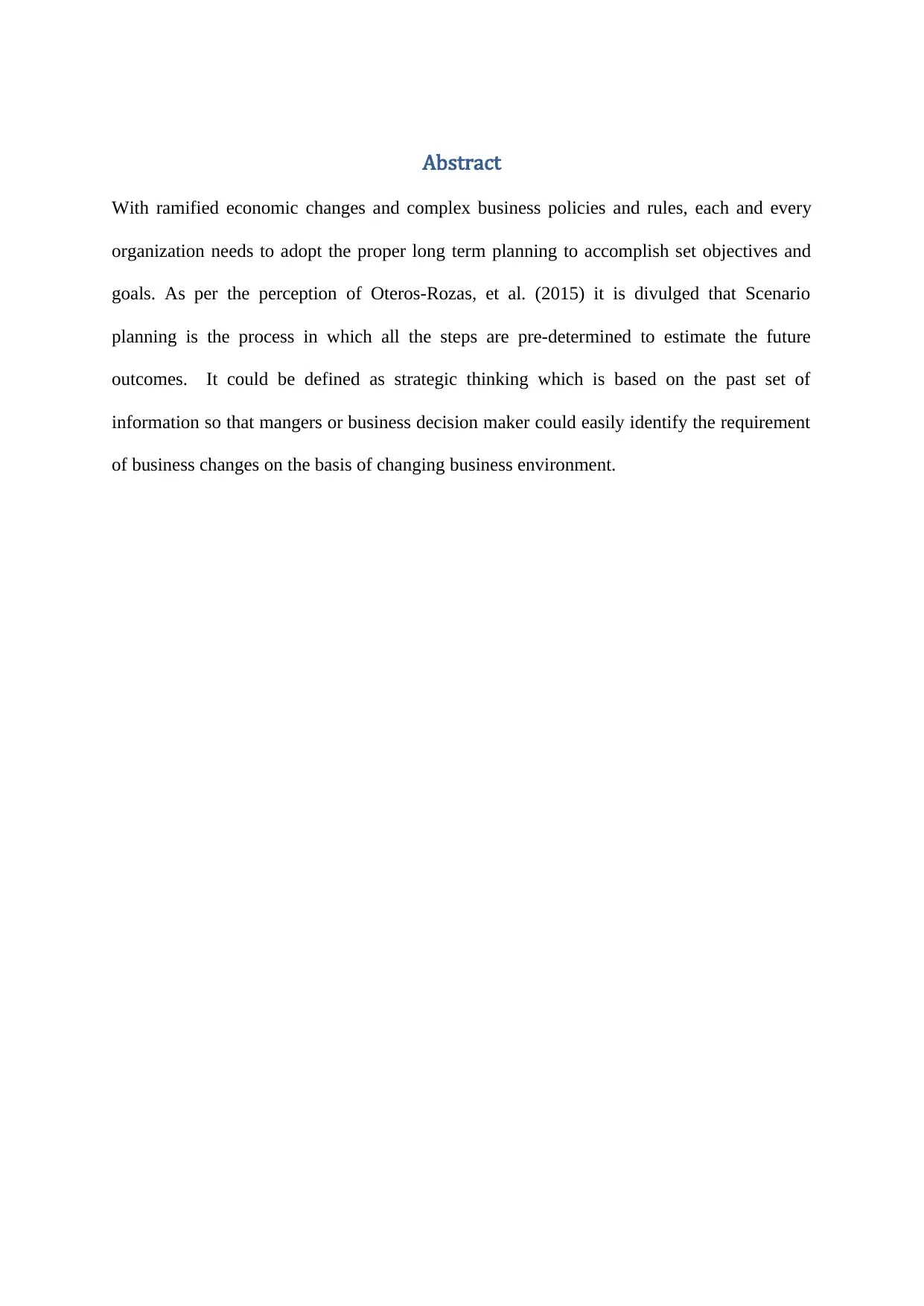
Abstract
With ramified economic changes and complex business policies and rules, each and every
organization needs to adopt the proper long term planning to accomplish set objectives and
goals. As per the perception of Oteros-Rozas, et al. (2015) it is divulged that Scenario
planning is the process in which all the steps are pre-determined to estimate the future
outcomes. It could be defined as strategic thinking which is based on the past set of
information so that mangers or business decision maker could easily identify the requirement
of business changes on the basis of changing business environment.
With ramified economic changes and complex business policies and rules, each and every
organization needs to adopt the proper long term planning to accomplish set objectives and
goals. As per the perception of Oteros-Rozas, et al. (2015) it is divulged that Scenario
planning is the process in which all the steps are pre-determined to estimate the future
outcomes. It could be defined as strategic thinking which is based on the past set of
information so that mangers or business decision maker could easily identify the requirement
of business changes on the basis of changing business environment.
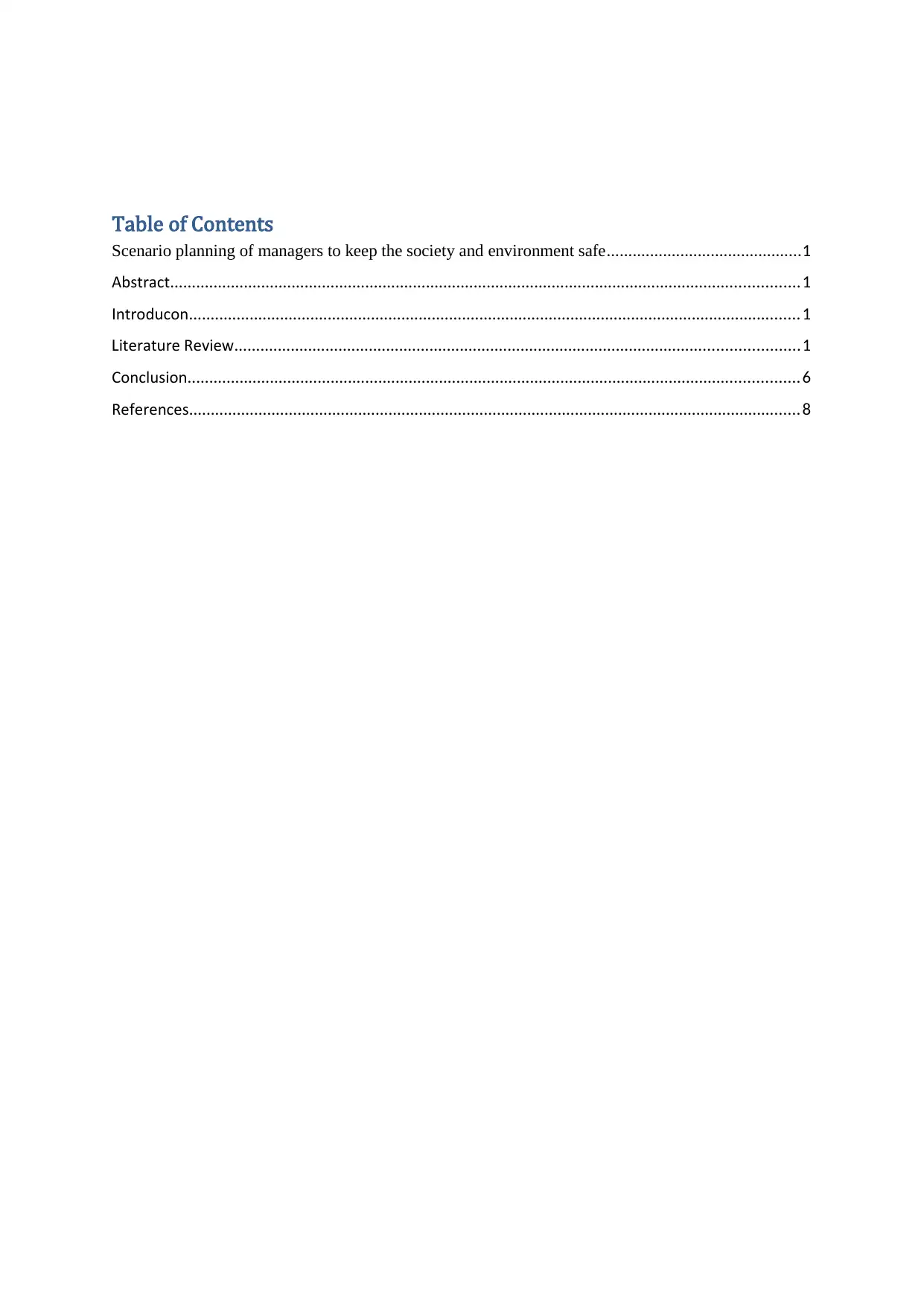
Table of Contents
Scenario planning of managers to keep the society and environment safe.............................................1
Abstract.................................................................................................................................................1
ntroductionI .............................................................................................................................................1
iterature ReviewL ..................................................................................................................................1
Conclusion.............................................................................................................................................6
References.............................................................................................................................................8
Scenario planning of managers to keep the society and environment safe.............................................1
Abstract.................................................................................................................................................1
ntroductionI .............................................................................................................................................1
iterature ReviewL ..................................................................................................................................1
Conclusion.............................................................................................................................................6
References.............................................................................................................................................8
⊘ This is a preview!⊘
Do you want full access?
Subscribe today to unlock all pages.

Trusted by 1+ million students worldwide
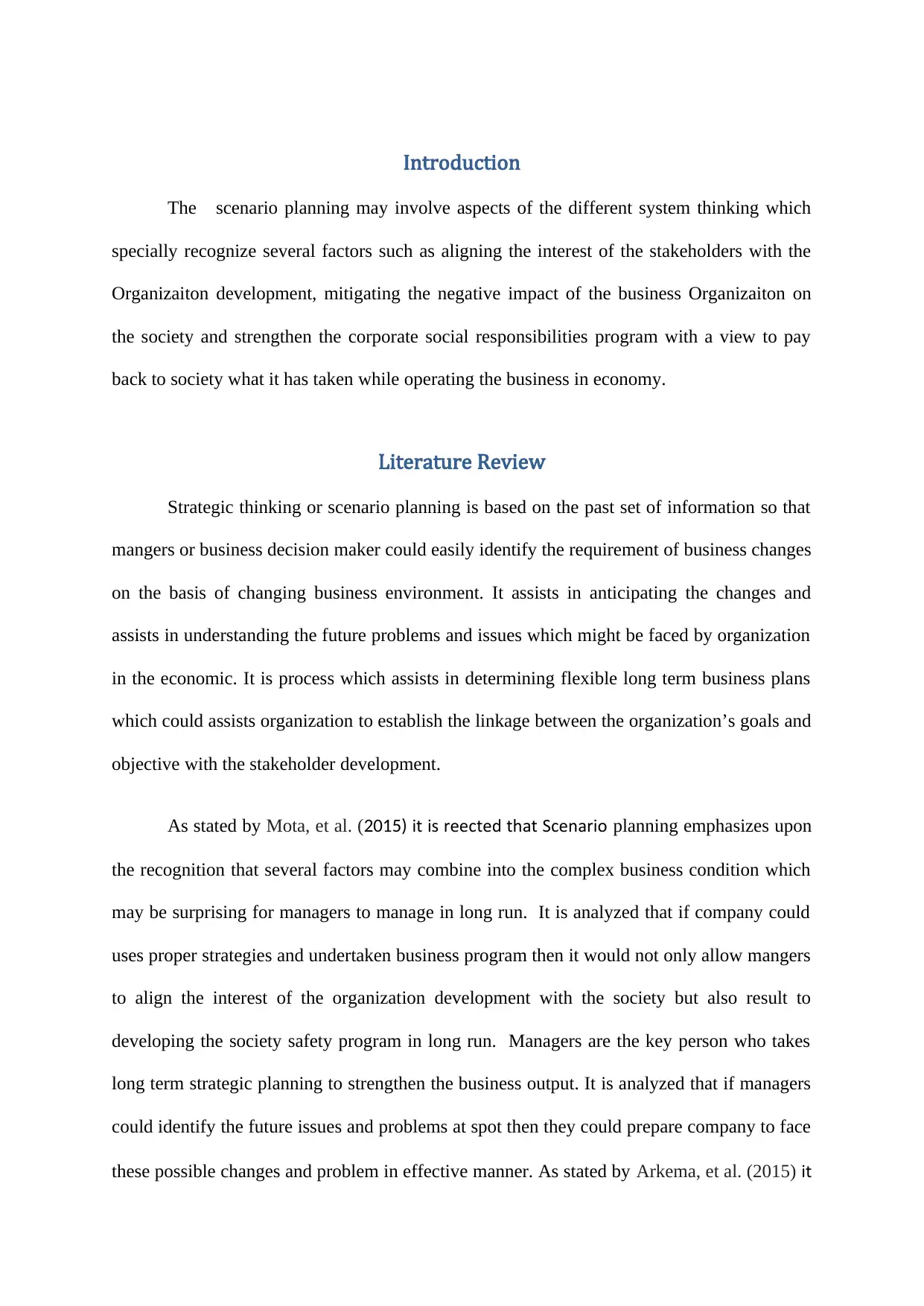
Introduction
The scenario planning may involve aspects of the different system thinking which
specially recognize several factors such as aligning the interest of the stakeholders with the
Organizaiton development, mitigating the negative impact of the business Organizaiton on
the society and strengthen the corporate social responsibilities program with a view to pay
back to society what it has taken while operating the business in economy.
Literature Review
Strategic thinking or scenario planning is based on the past set of information so that
mangers or business decision maker could easily identify the requirement of business changes
on the basis of changing business environment. It assists in anticipating the changes and
assists in understanding the future problems and issues which might be faced by organization
in the economic. It is process which assists in determining flexible long term business plans
which could assists organization to establish the linkage between the organization’s goals and
objective with the stakeholder development.
As stated by Mota, et al. ( it is reflected that Scenario2015) planning emphasizes upon
the recognition that several factors may combine into the complex business condition which
may be surprising for managers to manage in long run. It is analyzed that if company could
uses proper strategies and undertaken business program then it would not only allow mangers
to align the interest of the organization development with the society but also result to
developing the society safety program in long run. Managers are the key person who takes
long term strategic planning to strengthen the business output. It is analyzed that if managers
could identify the future issues and problems at spot then they could prepare company to face
these possible changes and problem in effective manner. As stated by Arkema, et al. (2015) it
The scenario planning may involve aspects of the different system thinking which
specially recognize several factors such as aligning the interest of the stakeholders with the
Organizaiton development, mitigating the negative impact of the business Organizaiton on
the society and strengthen the corporate social responsibilities program with a view to pay
back to society what it has taken while operating the business in economy.
Literature Review
Strategic thinking or scenario planning is based on the past set of information so that
mangers or business decision maker could easily identify the requirement of business changes
on the basis of changing business environment. It assists in anticipating the changes and
assists in understanding the future problems and issues which might be faced by organization
in the economic. It is process which assists in determining flexible long term business plans
which could assists organization to establish the linkage between the organization’s goals and
objective with the stakeholder development.
As stated by Mota, et al. ( it is reflected that Scenario2015) planning emphasizes upon
the recognition that several factors may combine into the complex business condition which
may be surprising for managers to manage in long run. It is analyzed that if company could
uses proper strategies and undertaken business program then it would not only allow mangers
to align the interest of the organization development with the society but also result to
developing the society safety program in long run. Managers are the key person who takes
long term strategic planning to strengthen the business output. It is analyzed that if managers
could identify the future issues and problems at spot then they could prepare company to face
these possible changes and problem in effective manner. As stated by Arkema, et al. (2015) it
Paraphrase This Document
Need a fresh take? Get an instant paraphrase of this document with our AI Paraphraser
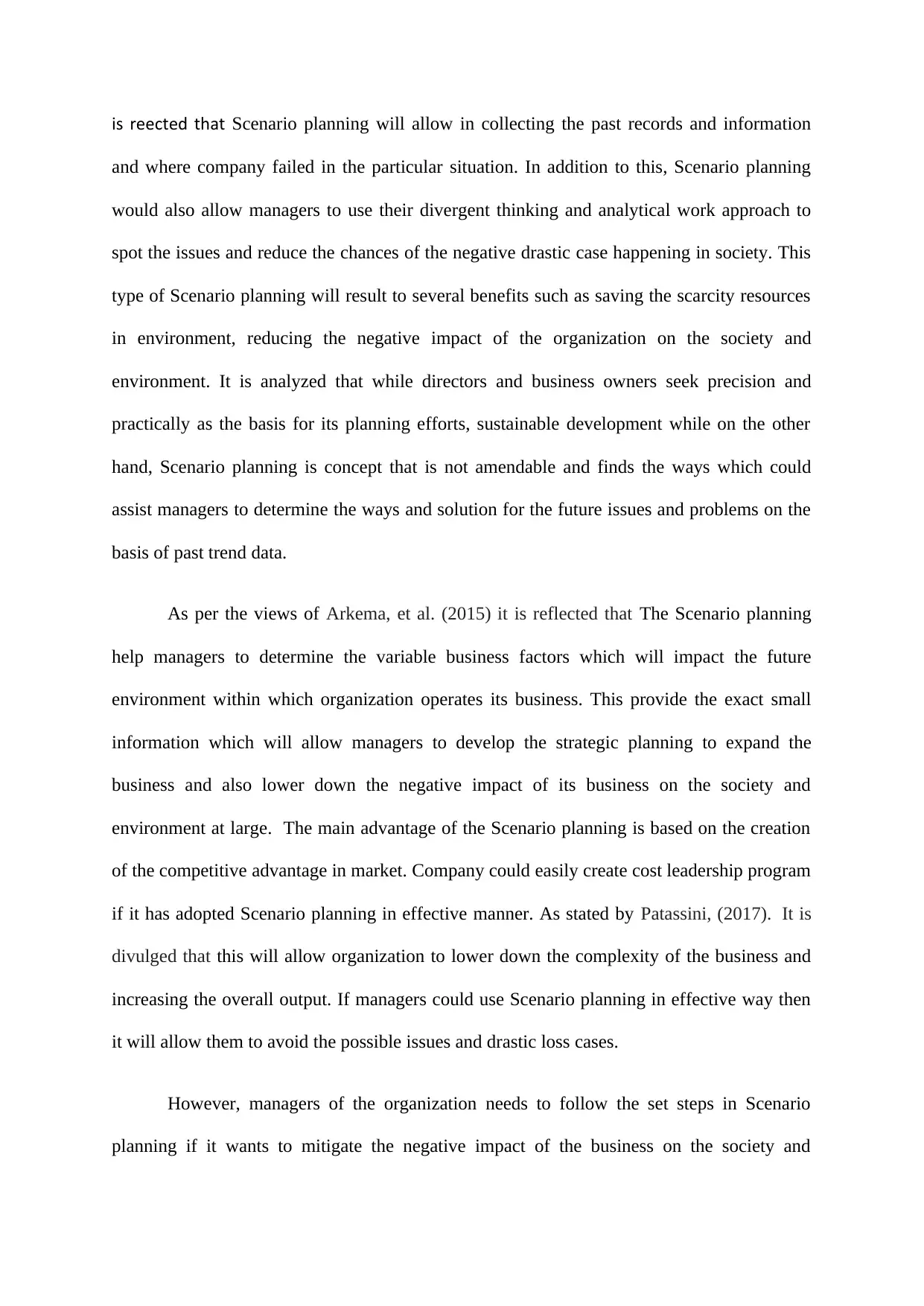
is reflected that Scenario planning will allow in collecting the past records and information
and where company failed in the particular situation. In addition to this, Scenario planning
would also allow managers to use their divergent thinking and analytical work approach to
spot the issues and reduce the chances of the negative drastic case happening in society. This
type of Scenario planning will result to several benefits such as saving the scarcity resources
in environment, reducing the negative impact of the organization on the society and
environment. It is analyzed that while directors and business owners seek precision and
practically as the basis for its planning efforts, sustainable development while on the other
hand, Scenario planning is concept that is not amendable and finds the ways which could
assist managers to determine the ways and solution for the future issues and problems on the
basis of past trend data.
As per the views of Arkema, et al. (2015) it is reflected that The Scenario planning
help managers to determine the variable business factors which will impact the future
environment within which organization operates its business. This provide the exact small
information which will allow managers to develop the strategic planning to expand the
business and also lower down the negative impact of its business on the society and
environment at large. The main advantage of the Scenario planning is based on the creation
of the competitive advantage in market. Company could easily create cost leadership program
if it has adopted Scenario planning in effective manner. As stated by Patassini, (2017). It is
divulged that this will allow organization to lower down the complexity of the business and
increasing the overall output. If managers could use Scenario planning in effective way then
it will allow them to avoid the possible issues and drastic loss cases.
However, managers of the organization needs to follow the set steps in Scenario
planning if it wants to mitigate the negative impact of the business on the society and
and where company failed in the particular situation. In addition to this, Scenario planning
would also allow managers to use their divergent thinking and analytical work approach to
spot the issues and reduce the chances of the negative drastic case happening in society. This
type of Scenario planning will result to several benefits such as saving the scarcity resources
in environment, reducing the negative impact of the organization on the society and
environment. It is analyzed that while directors and business owners seek precision and
practically as the basis for its planning efforts, sustainable development while on the other
hand, Scenario planning is concept that is not amendable and finds the ways which could
assist managers to determine the ways and solution for the future issues and problems on the
basis of past trend data.
As per the views of Arkema, et al. (2015) it is reflected that The Scenario planning
help managers to determine the variable business factors which will impact the future
environment within which organization operates its business. This provide the exact small
information which will allow managers to develop the strategic planning to expand the
business and also lower down the negative impact of its business on the society and
environment at large. The main advantage of the Scenario planning is based on the creation
of the competitive advantage in market. Company could easily create cost leadership program
if it has adopted Scenario planning in effective manner. As stated by Patassini, (2017). It is
divulged that this will allow organization to lower down the complexity of the business and
increasing the overall output. If managers could use Scenario planning in effective way then
it will allow them to avoid the possible issues and drastic loss cases.
However, managers of the organization needs to follow the set steps in Scenario
planning if it wants to mitigate the negative impact of the business on the society and
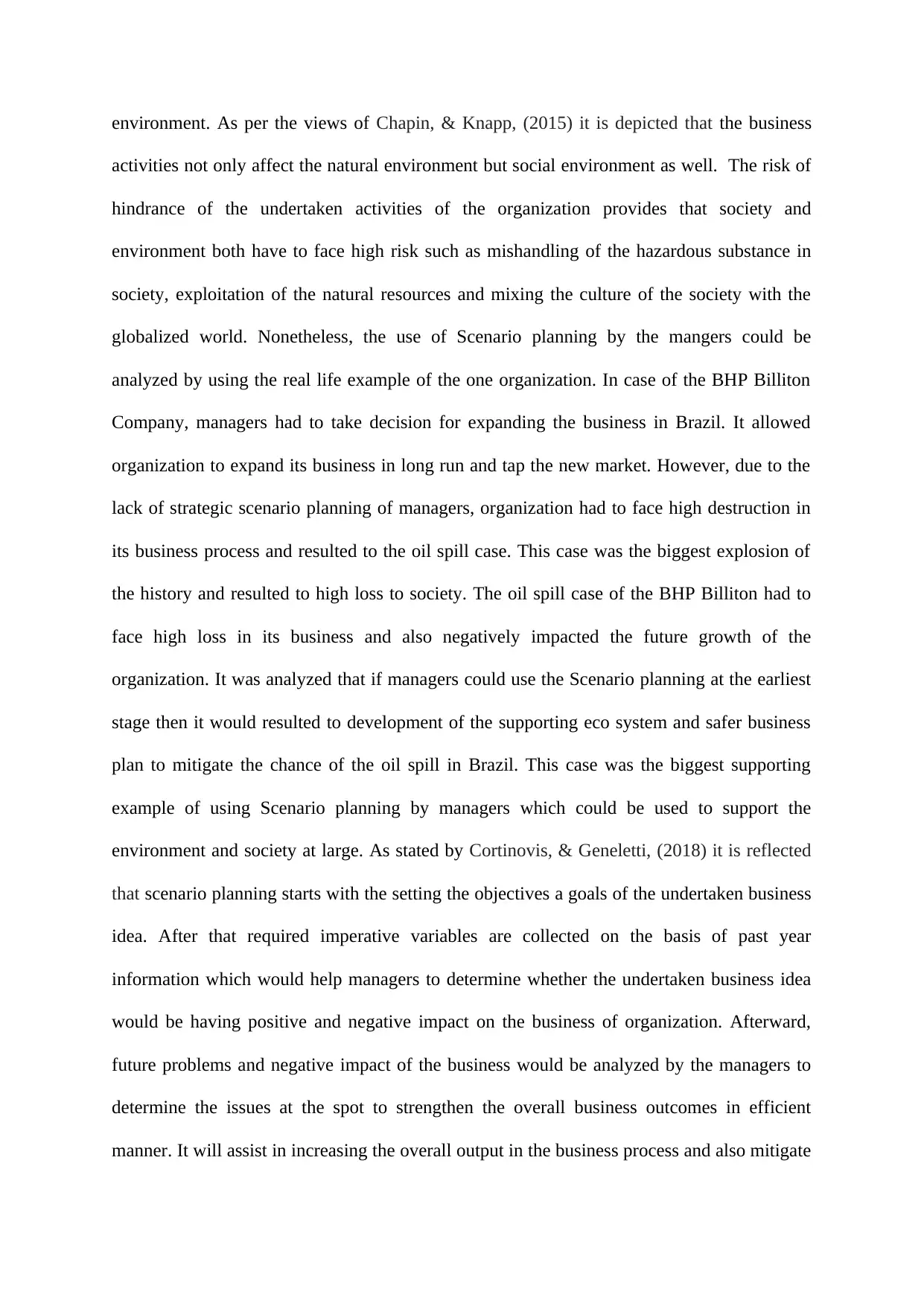
environment. As per the views of Chapin, & Knapp, (2015) it is depicted that the business
activities not only affect the natural environment but social environment as well. The risk of
hindrance of the undertaken activities of the organization provides that society and
environment both have to face high risk such as mishandling of the hazardous substance in
society, exploitation of the natural resources and mixing the culture of the society with the
globalized world. Nonetheless, the use of Scenario planning by the mangers could be
analyzed by using the real life example of the one organization. In case of the BHP Billiton
Company, managers had to take decision for expanding the business in Brazil. It allowed
organization to expand its business in long run and tap the new market. However, due to the
lack of strategic scenario planning of managers, organization had to face high destruction in
its business process and resulted to the oil spill case. This case was the biggest explosion of
the history and resulted to high loss to society. The oil spill case of the BHP Billiton had to
face high loss in its business and also negatively impacted the future growth of the
organization. It was analyzed that if managers could use the Scenario planning at the earliest
stage then it would resulted to development of the supporting eco system and safer business
plan to mitigate the chance of the oil spill in Brazil. This case was the biggest supporting
example of using Scenario planning by managers which could be used to support the
environment and society at large. As stated by Cortinovis, & Geneletti, (2018) it is reflected
that scenario planning starts with the setting the objectives a goals of the undertaken business
idea. After that required imperative variables are collected on the basis of past year
information which would help managers to determine whether the undertaken business idea
would be having positive and negative impact on the business of organization. Afterward,
future problems and negative impact of the business would be analyzed by the managers to
determine the issues at the spot to strengthen the overall business outcomes in efficient
manner. It will assist in increasing the overall output in the business process and also mitigate
activities not only affect the natural environment but social environment as well. The risk of
hindrance of the undertaken activities of the organization provides that society and
environment both have to face high risk such as mishandling of the hazardous substance in
society, exploitation of the natural resources and mixing the culture of the society with the
globalized world. Nonetheless, the use of Scenario planning by the mangers could be
analyzed by using the real life example of the one organization. In case of the BHP Billiton
Company, managers had to take decision for expanding the business in Brazil. It allowed
organization to expand its business in long run and tap the new market. However, due to the
lack of strategic scenario planning of managers, organization had to face high destruction in
its business process and resulted to the oil spill case. This case was the biggest explosion of
the history and resulted to high loss to society. The oil spill case of the BHP Billiton had to
face high loss in its business and also negatively impacted the future growth of the
organization. It was analyzed that if managers could use the Scenario planning at the earliest
stage then it would resulted to development of the supporting eco system and safer business
plan to mitigate the chance of the oil spill in Brazil. This case was the biggest supporting
example of using Scenario planning by managers which could be used to support the
environment and society at large. As stated by Cortinovis, & Geneletti, (2018) it is reflected
that scenario planning starts with the setting the objectives a goals of the undertaken business
idea. After that required imperative variables are collected on the basis of past year
information which would help managers to determine whether the undertaken business idea
would be having positive and negative impact on the business of organization. Afterward,
future problems and negative impact of the business would be analyzed by the managers to
determine the issues at the spot to strengthen the overall business outcomes in efficient
manner. It will assist in increasing the overall output in the business process and also mitigate
⊘ This is a preview!⊘
Do you want full access?
Subscribe today to unlock all pages.

Trusted by 1+ million students worldwide
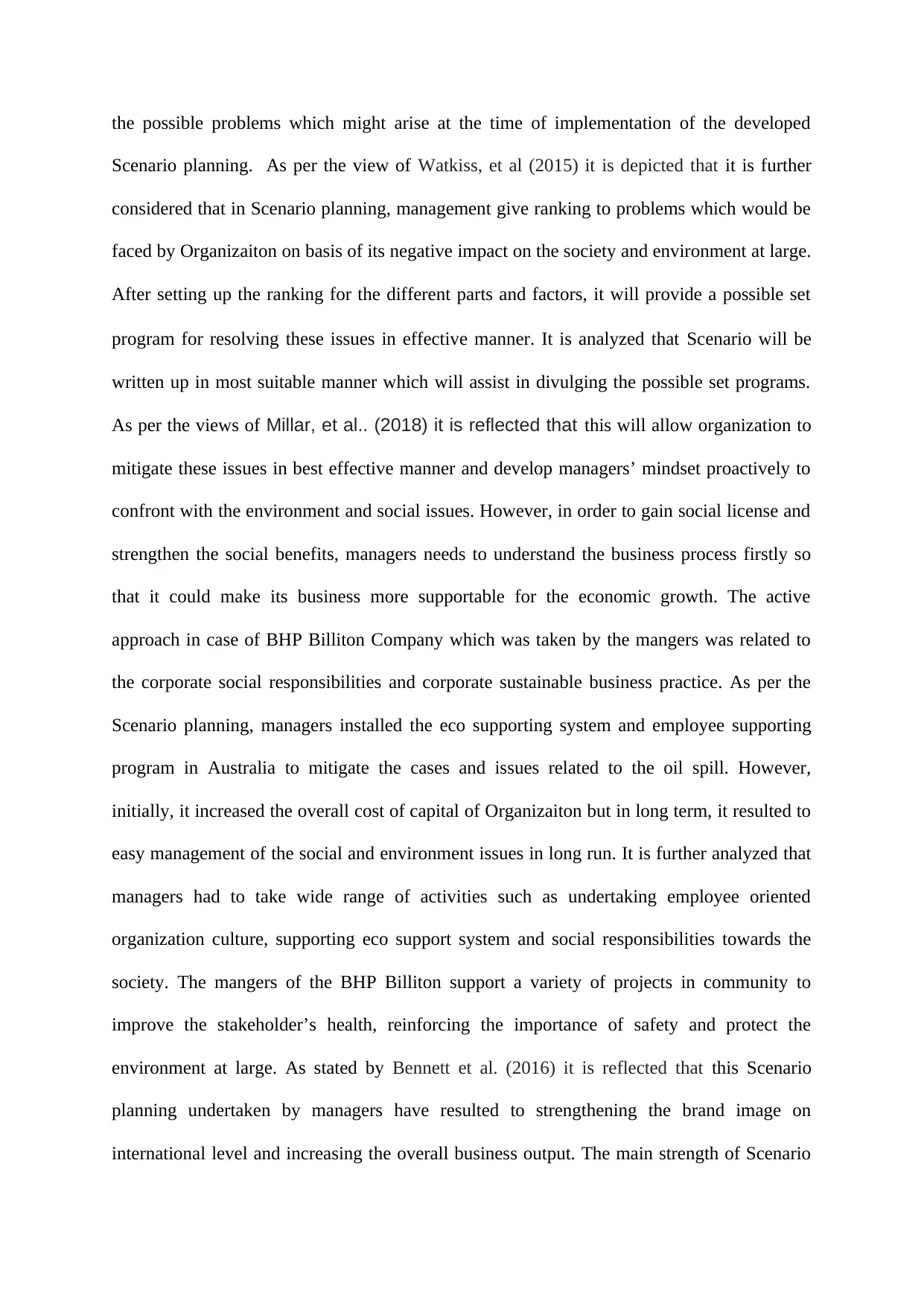
the possible problems which might arise at the time of implementation of the developed
Scenario planning. As per the view of Watkiss, et al (2015) it is depicted that it is further
considered that in Scenario planning, management give ranking to problems which would be
faced by Organizaiton on basis of its negative impact on the society and environment at large.
After setting up the ranking for the different parts and factors, it will provide a possible set
program for resolving these issues in effective manner. It is analyzed that Scenario will be
written up in most suitable manner which will assist in divulging the possible set programs.
As per the views of Millar, et al.. (2018) it is reflected that this will allow organization to
mitigate these issues in best effective manner and develop managers’ mindset proactively to
confront with the environment and social issues. However, in order to gain social license and
strengthen the social benefits, managers needs to understand the business process firstly so
that it could make its business more supportable for the economic growth. The active
approach in case of BHP Billiton Company which was taken by the mangers was related to
the corporate social responsibilities and corporate sustainable business practice. As per the
Scenario planning, managers installed the eco supporting system and employee supporting
program in Australia to mitigate the cases and issues related to the oil spill. However,
initially, it increased the overall cost of capital of Organizaiton but in long term, it resulted to
easy management of the social and environment issues in long run. It is further analyzed that
managers had to take wide range of activities such as undertaking employee oriented
organization culture, supporting eco support system and social responsibilities towards the
society. The mangers of the BHP Billiton support a variety of projects in community to
improve the stakeholder’s health, reinforcing the importance of safety and protect the
environment at large. As stated by Bennett et al. (2016) it is reflected that this Scenario
planning undertaken by managers have resulted to strengthening the brand image on
international level and increasing the overall business output. The main strength of Scenario
Scenario planning. As per the view of Watkiss, et al (2015) it is depicted that it is further
considered that in Scenario planning, management give ranking to problems which would be
faced by Organizaiton on basis of its negative impact on the society and environment at large.
After setting up the ranking for the different parts and factors, it will provide a possible set
program for resolving these issues in effective manner. It is analyzed that Scenario will be
written up in most suitable manner which will assist in divulging the possible set programs.
As per the views of Millar, et al.. (2018) it is reflected that this will allow organization to
mitigate these issues in best effective manner and develop managers’ mindset proactively to
confront with the environment and social issues. However, in order to gain social license and
strengthen the social benefits, managers needs to understand the business process firstly so
that it could make its business more supportable for the economic growth. The active
approach in case of BHP Billiton Company which was taken by the mangers was related to
the corporate social responsibilities and corporate sustainable business practice. As per the
Scenario planning, managers installed the eco supporting system and employee supporting
program in Australia to mitigate the cases and issues related to the oil spill. However,
initially, it increased the overall cost of capital of Organizaiton but in long term, it resulted to
easy management of the social and environment issues in long run. It is further analyzed that
managers had to take wide range of activities such as undertaking employee oriented
organization culture, supporting eco support system and social responsibilities towards the
society. The mangers of the BHP Billiton support a variety of projects in community to
improve the stakeholder’s health, reinforcing the importance of safety and protect the
environment at large. As stated by Bennett et al. (2016) it is reflected that this Scenario
planning undertaken by managers have resulted to strengthening the brand image on
international level and increasing the overall business output. The main strength of Scenario
Paraphrase This Document
Need a fresh take? Get an instant paraphrase of this document with our AI Paraphraser
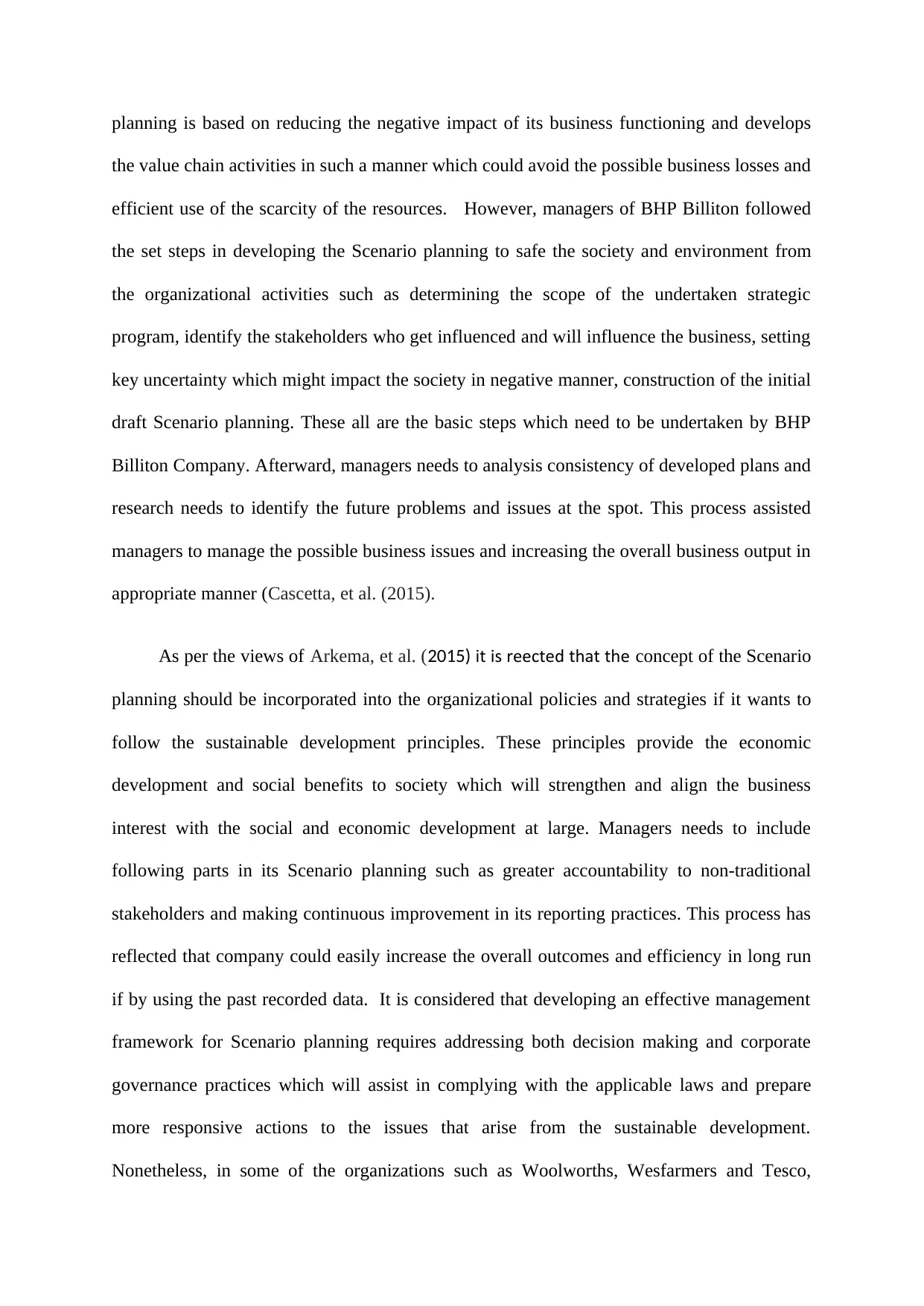
planning is based on reducing the negative impact of its business functioning and develops
the value chain activities in such a manner which could avoid the possible business losses and
efficient use of the scarcity of the resources. However, managers of BHP Billiton followed
the set steps in developing the Scenario planning to safe the society and environment from
the organizational activities such as determining the scope of the undertaken strategic
program, identify the stakeholders who get influenced and will influence the business, setting
key uncertainty which might impact the society in negative manner, construction of the initial
draft Scenario planning. These all are the basic steps which need to be undertaken by BHP
Billiton Company. Afterward, managers needs to analysis consistency of developed plans and
research needs to identify the future problems and issues at the spot. This process assisted
managers to manage the possible business issues and increasing the overall business output in
appropriate manner (Cascetta, et al. (2015).
As per the views of Arkema, et al. ( it is reflected that the2015) concept of the Scenario
planning should be incorporated into the organizational policies and strategies if it wants to
follow the sustainable development principles. These principles provide the economic
development and social benefits to society which will strengthen and align the business
interest with the social and economic development at large. Managers needs to include
following parts in its Scenario planning such as greater accountability to non-traditional
stakeholders and making continuous improvement in its reporting practices. This process has
reflected that company could easily increase the overall outcomes and efficiency in long run
if by using the past recorded data. It is considered that developing an effective management
framework for Scenario planning requires addressing both decision making and corporate
governance practices which will assist in complying with the applicable laws and prepare
more responsive actions to the issues that arise from the sustainable development.
Nonetheless, in some of the organizations such as Woolworths, Wesfarmers and Tesco,
the value chain activities in such a manner which could avoid the possible business losses and
efficient use of the scarcity of the resources. However, managers of BHP Billiton followed
the set steps in developing the Scenario planning to safe the society and environment from
the organizational activities such as determining the scope of the undertaken strategic
program, identify the stakeholders who get influenced and will influence the business, setting
key uncertainty which might impact the society in negative manner, construction of the initial
draft Scenario planning. These all are the basic steps which need to be undertaken by BHP
Billiton Company. Afterward, managers needs to analysis consistency of developed plans and
research needs to identify the future problems and issues at the spot. This process assisted
managers to manage the possible business issues and increasing the overall business output in
appropriate manner (Cascetta, et al. (2015).
As per the views of Arkema, et al. ( it is reflected that the2015) concept of the Scenario
planning should be incorporated into the organizational policies and strategies if it wants to
follow the sustainable development principles. These principles provide the economic
development and social benefits to society which will strengthen and align the business
interest with the social and economic development at large. Managers needs to include
following parts in its Scenario planning such as greater accountability to non-traditional
stakeholders and making continuous improvement in its reporting practices. This process has
reflected that company could easily increase the overall outcomes and efficiency in long run
if by using the past recorded data. It is considered that developing an effective management
framework for Scenario planning requires addressing both decision making and corporate
governance practices which will assist in complying with the applicable laws and prepare
more responsive actions to the issues that arise from the sustainable development.
Nonetheless, in some of the organizations such as Woolworths, Wesfarmers and Tesco,
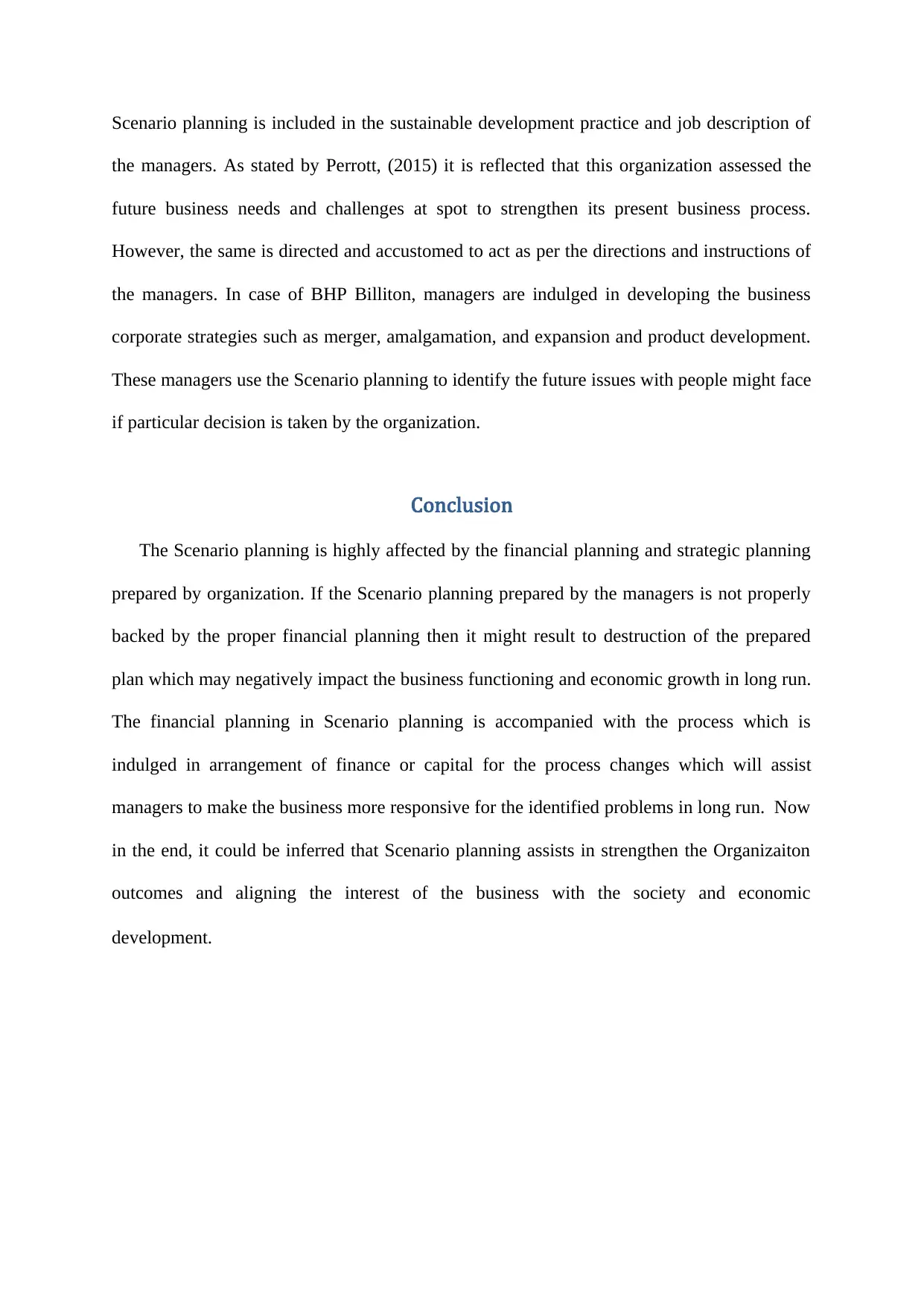
Scenario planning is included in the sustainable development practice and job description of
the managers. As stated by Perrott, (2015) it is reflected that this organization assessed the
future business needs and challenges at spot to strengthen its present business process.
However, the same is directed and accustomed to act as per the directions and instructions of
the managers. In case of BHP Billiton, managers are indulged in developing the business
corporate strategies such as merger, amalgamation, and expansion and product development.
These managers use the Scenario planning to identify the future issues with people might face
if particular decision is taken by the organization.
Conclusion
The Scenario planning is highly affected by the financial planning and strategic planning
prepared by organization. If the Scenario planning prepared by the managers is not properly
backed by the proper financial planning then it might result to destruction of the prepared
plan which may negatively impact the business functioning and economic growth in long run.
The financial planning in Scenario planning is accompanied with the process which is
indulged in arrangement of finance or capital for the process changes which will assist
managers to make the business more responsive for the identified problems in long run. Now
in the end, it could be inferred that Scenario planning assists in strengthen the Organizaiton
outcomes and aligning the interest of the business with the society and economic
development.
the managers. As stated by Perrott, (2015) it is reflected that this organization assessed the
future business needs and challenges at spot to strengthen its present business process.
However, the same is directed and accustomed to act as per the directions and instructions of
the managers. In case of BHP Billiton, managers are indulged in developing the business
corporate strategies such as merger, amalgamation, and expansion and product development.
These managers use the Scenario planning to identify the future issues with people might face
if particular decision is taken by the organization.
Conclusion
The Scenario planning is highly affected by the financial planning and strategic planning
prepared by organization. If the Scenario planning prepared by the managers is not properly
backed by the proper financial planning then it might result to destruction of the prepared
plan which may negatively impact the business functioning and economic growth in long run.
The financial planning in Scenario planning is accompanied with the process which is
indulged in arrangement of finance or capital for the process changes which will assist
managers to make the business more responsive for the identified problems in long run. Now
in the end, it could be inferred that Scenario planning assists in strengthen the Organizaiton
outcomes and aligning the interest of the business with the society and economic
development.
⊘ This is a preview!⊘
Do you want full access?
Subscribe today to unlock all pages.

Trusted by 1+ million students worldwide
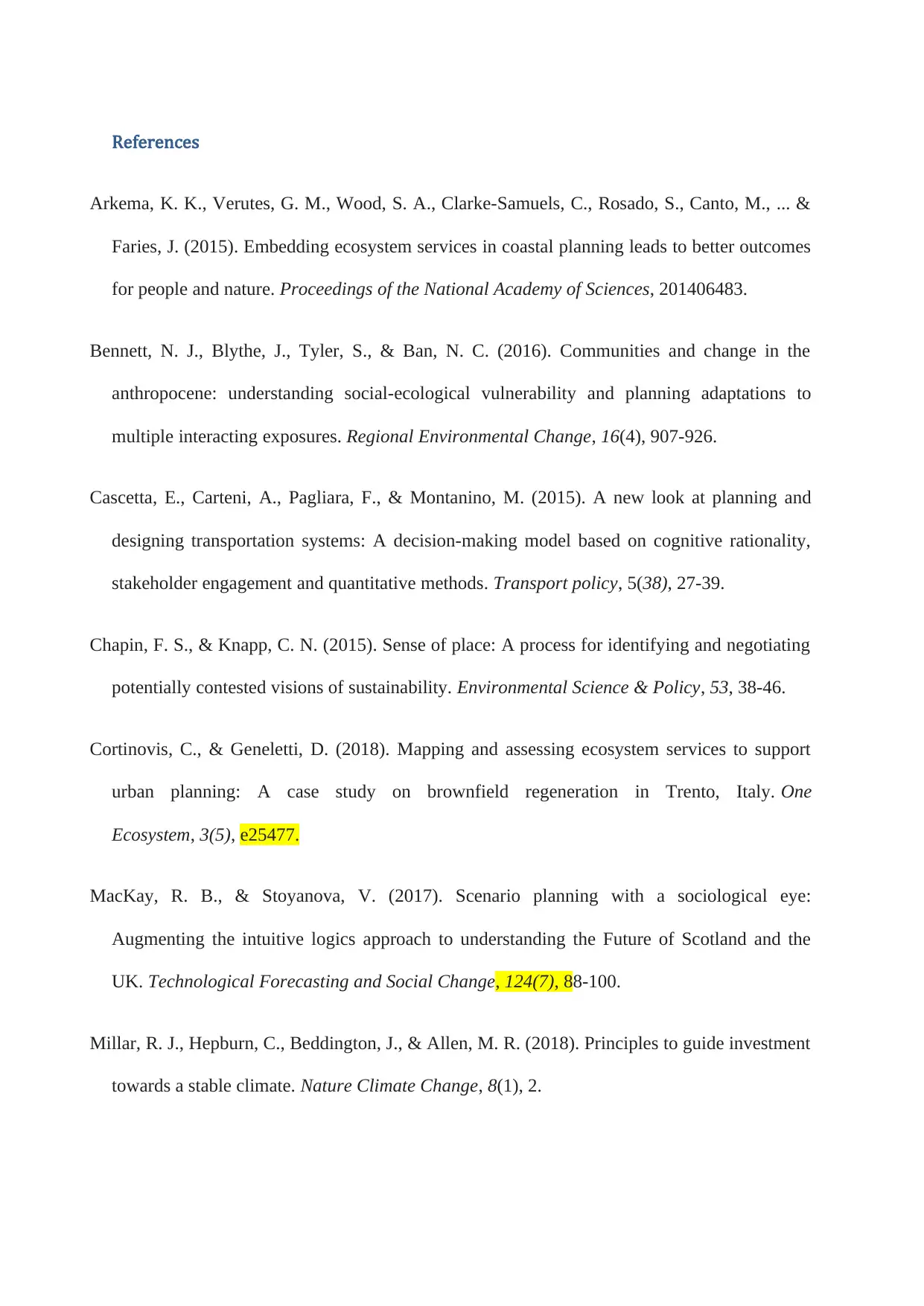
References
Arkema, K. K., Verutes, G. M., Wood, S. A., Clarke-Samuels, C., Rosado, S., Canto, M., ... &
Faries, J. (2015). Embedding ecosystem services in coastal planning leads to better outcomes
for people and nature. Proceedings of the National Academy of Sciences, 201406483.
Bennett, N. J., Blythe, J., Tyler, S., & Ban, N. C. (2016). Communities and change in the
anthropocene: understanding social-ecological vulnerability and planning adaptations to
multiple interacting exposures. Regional Environmental Change, 16(4), 907-926.
Cascetta, E., Carteni, A., Pagliara, F., & Montanino, M. (2015). A new look at planning and
designing transportation systems: A decision-making model based on cognitive rationality,
stakeholder engagement and quantitative methods. Transport policy, 5(38), 27-39.
Chapin, F. S., & Knapp, C. N. (2015). Sense of place: A process for identifying and negotiating
potentially contested visions of sustainability. Environmental Science & Policy, 53, 38-46.
Cortinovis, C., & Geneletti, D. (2018). Mapping and assessing ecosystem services to support
urban planning: A case study on brownfield regeneration in Trento, Italy. One
Ecosystem, 3(5), e25477.
MacKay, R. B., & Stoyanova, V. (2017). Scenario planning with a sociological eye:
Augmenting the intuitive logics approach to understanding the Future of Scotland and the
UK. Technological Forecasting and Social Change, 124(7), 88-100.
Millar, R. J., Hepburn, C., Beddington, J., & Allen, M. R. (2018). Principles to guide investment
towards a stable climate. Nature Climate Change, 8(1), 2.
Arkema, K. K., Verutes, G. M., Wood, S. A., Clarke-Samuels, C., Rosado, S., Canto, M., ... &
Faries, J. (2015). Embedding ecosystem services in coastal planning leads to better outcomes
for people and nature. Proceedings of the National Academy of Sciences, 201406483.
Bennett, N. J., Blythe, J., Tyler, S., & Ban, N. C. (2016). Communities and change in the
anthropocene: understanding social-ecological vulnerability and planning adaptations to
multiple interacting exposures. Regional Environmental Change, 16(4), 907-926.
Cascetta, E., Carteni, A., Pagliara, F., & Montanino, M. (2015). A new look at planning and
designing transportation systems: A decision-making model based on cognitive rationality,
stakeholder engagement and quantitative methods. Transport policy, 5(38), 27-39.
Chapin, F. S., & Knapp, C. N. (2015). Sense of place: A process for identifying and negotiating
potentially contested visions of sustainability. Environmental Science & Policy, 53, 38-46.
Cortinovis, C., & Geneletti, D. (2018). Mapping and assessing ecosystem services to support
urban planning: A case study on brownfield regeneration in Trento, Italy. One
Ecosystem, 3(5), e25477.
MacKay, R. B., & Stoyanova, V. (2017). Scenario planning with a sociological eye:
Augmenting the intuitive logics approach to understanding the Future of Scotland and the
UK. Technological Forecasting and Social Change, 124(7), 88-100.
Millar, R. J., Hepburn, C., Beddington, J., & Allen, M. R. (2018). Principles to guide investment
towards a stable climate. Nature Climate Change, 8(1), 2.
Paraphrase This Document
Need a fresh take? Get an instant paraphrase of this document with our AI Paraphraser
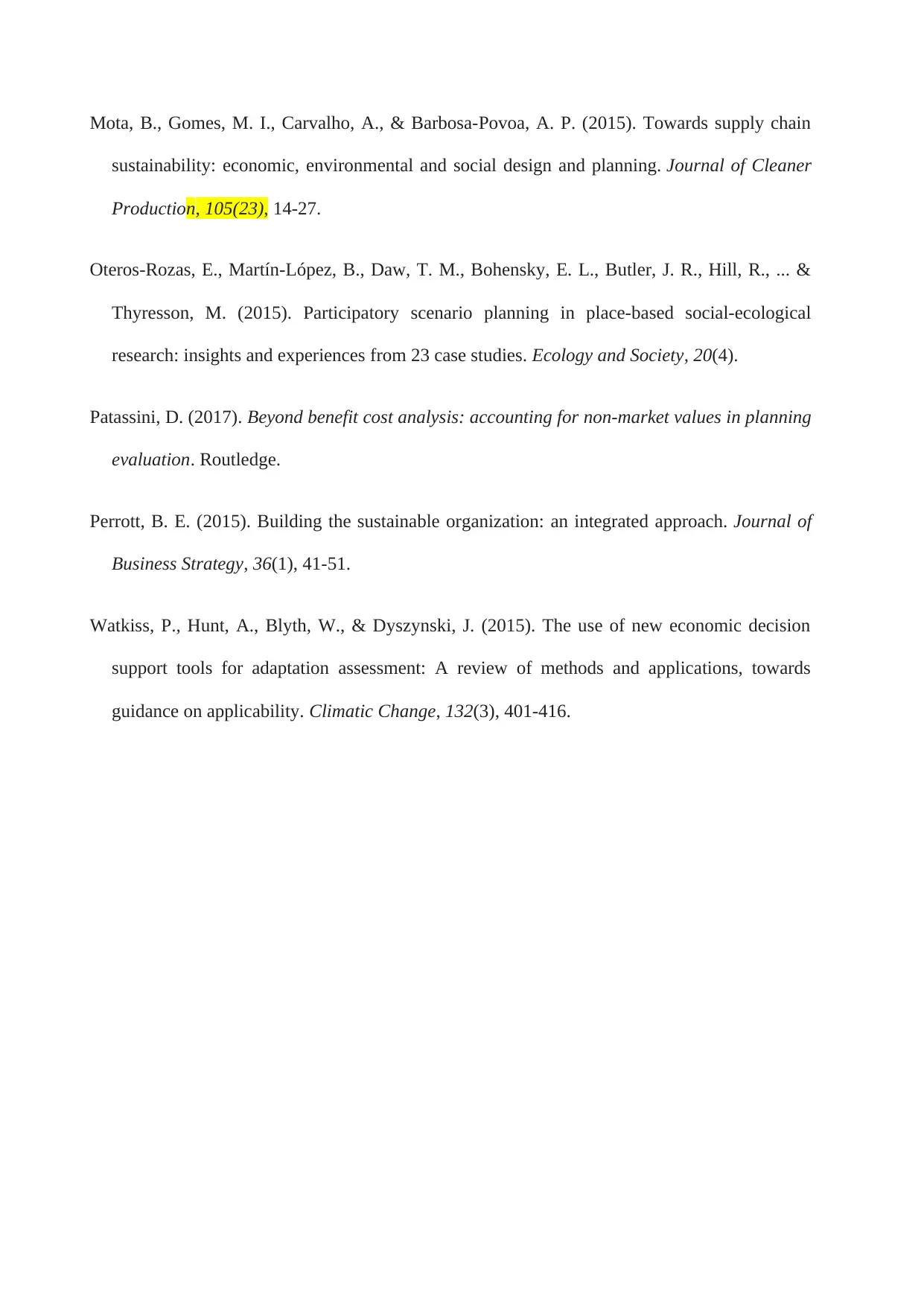
Mota, B., Gomes, M. I., Carvalho, A., & Barbosa-Povoa, A. P. (2015). Towards supply chain
sustainability: economic, environmental and social design and planning. Journal of Cleaner
Production, 105(23), 14-27.
Oteros-Rozas, E., Martín-López, B., Daw, T. M., Bohensky, E. L., Butler, J. R., Hill, R., ... &
Thyresson, M. (2015). Participatory scenario planning in place-based social-ecological
research: insights and experiences from 23 case studies. Ecology and Society, 20(4).
Patassini, D. (2017). Beyond benefit cost analysis: accounting for non-market values in planning
evaluation. Routledge.
Perrott, B. E. (2015). Building the sustainable organization: an integrated approach. Journal of
Business Strategy, 36(1), 41-51.
Watkiss, P., Hunt, A., Blyth, W., & Dyszynski, J. (2015). The use of new economic decision
support tools for adaptation assessment: A review of methods and applications, towards
guidance on applicability. Climatic Change, 132(3), 401-416.
sustainability: economic, environmental and social design and planning. Journal of Cleaner
Production, 105(23), 14-27.
Oteros-Rozas, E., Martín-López, B., Daw, T. M., Bohensky, E. L., Butler, J. R., Hill, R., ... &
Thyresson, M. (2015). Participatory scenario planning in place-based social-ecological
research: insights and experiences from 23 case studies. Ecology and Society, 20(4).
Patassini, D. (2017). Beyond benefit cost analysis: accounting for non-market values in planning
evaluation. Routledge.
Perrott, B. E. (2015). Building the sustainable organization: an integrated approach. Journal of
Business Strategy, 36(1), 41-51.
Watkiss, P., Hunt, A., Blyth, W., & Dyszynski, J. (2015). The use of new economic decision
support tools for adaptation assessment: A review of methods and applications, towards
guidance on applicability. Climatic Change, 132(3), 401-416.
1 out of 11
Related Documents
Your All-in-One AI-Powered Toolkit for Academic Success.
+13062052269
info@desklib.com
Available 24*7 on WhatsApp / Email
![[object Object]](/_next/static/media/star-bottom.7253800d.svg)
Unlock your academic potential
Copyright © 2020–2025 A2Z Services. All Rights Reserved. Developed and managed by ZUCOL.



